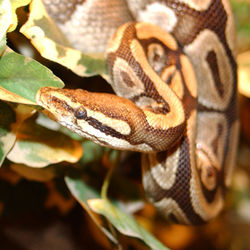


|
Pythoninae:
Python is the common name for a group of non-venomous constricting snakes, specifically the family Pythonidae. Other sources consider this group a subfamily of the Boas (Pythoninae). Pythons are more related to boas than to any other snake-family. There is also a genus within Pythonidae which carries the name Python (Daudin, 1803). Pythons are distinguishable from boas in that they have teeth on the premaxilla, a small bone at the very front and center of the upper jaw. Most boas produce live young, while pythons produce eggs. Some species of sandboas (Ericinae) are also called python. Pythons range in size from 1 to 6 metres (3 to 20 feet) in length. Some pythons are among the longest species of snakes in the world; according to the Guinness Book of World Records the Reticulated Python holds the record for longest snake, at 10 m (32 ft 9.5 in). Some species exhibit vestigial bones of the pelvis and rear legs, which are externally apparent in the form of a pair of anal spurs on each side of the cloaca. These spurs are larger in males than females, and are used by the male to stimulate the female during copulation. Some pythons display vivid patterns on their scales while others are a nondescript brown. They usually reflect appropriate camouflage for their native habitat.
|
